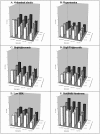Joint Association of Dietary Pattern and Physical Activity Level with Cardiovascular Disease Risk Factors among Chinese Men: A Cross-Sectional Study
- PMID: 23840426
- PMCID: PMC3686814
- DOI: 10.1371/journal.pone.0066210
Joint Association of Dietary Pattern and Physical Activity Level with Cardiovascular Disease Risk Factors among Chinese Men: A Cross-Sectional Study
Abstract
The purpose of this cross-sectional study was to investigate the joint associations of physical activity level (PAL) and dietary patterns in relation to cardiovascular disease (CVD) risk factors among Chinese men. The study population consisted of 13 511 Chinese males aged 18-59 years from the 2002 China National Nutrition and Health Survey. Based on dietary data collected by a food frequency questionnaire, four dietary patterns were identified and labeled as "Green Water" (high consumption of rice, vegetables, seafood, pork, and poultry), "Yellow Earth" (high consumption of wheat flour products and starchy tubers), "New Affluent" (high consumption of animal sourced foods and soybean products), and "Western Adopter" (high consumption of animal sourced foods, cakes, and soft drinks). From the information collected by a 1-year physical activity questionnaire, PAL was calculated and classified into 4 categories: sedentary, low active, active, and very active. As compared with their counterparts from the New Affluent pattern, participants who followed the Green Water pattern had a lower likelihood of abdominal obesity (AO; 50.2%), hypertension (HT; 37.9%), hyperglycemia (HG; 41.5%), elevated triglyceride (ETG; 14.5%), low HDL (LHDL; 39.8%), and metabolic syndrome (MS; 51.9%). When compared to sedentary participants, the odds ratio of participants with very active PAL was 0.62 for AO, 0.85 for HT, 0.71 for HG, 0.76 for ETG, 0.74 for LHDL, and 0.58 for MS. Individuals who followed both very active PAL and the Green Water pattern had a lower likelihood of CVD risk factors (AO: 65.8%, HT: 39.1%, HG: 57.4%, ETG: 35.4%, LHDL: 56.1%, and MS: 75.0%), compared to their counterparts who followed both sedentary PAL and the New Affluent pattern. In addition, adherence to both healthy dietary pattern and very active PAL presented a remarkable potential for CVD risk factor prevention.
Conflict of interest statement
Figures
Similar articles
-
Dietary patterns as compared with physical activity in relation to metabolic syndrome among Chinese adults.Nutr Metab Cardiovasc Dis. 2013 Oct;23(10):920-8. doi: 10.1016/j.numecd.2012.09.001. Epub 2012 Nov 10. Nutr Metab Cardiovasc Dis. 2013. PMID: 23146360
-
Associations of food consumption, serum vitamins and metabolic syndrome risk with physical activity level in middle-aged adults: the National Health and Nutrition Examination Survey (NHANES) 2005-2006.Public Health Nutr. 2016 Jun;19(9):1674-83. doi: 10.1017/S1368980015003742. Epub 2016 Feb 17. Public Health Nutr. 2016. PMID: 26883125 Free PMC article.
-
Dietary Patterns Associated with the Prevalence of Cardiovascular Disease Risk Factors in Kuwaiti Adults.J Acad Nutr Diet. 2020 Mar;120(3):424-436. doi: 10.1016/j.jand.2019.09.012. Epub 2019 Nov 18. J Acad Nutr Diet. 2020. PMID: 31753772
-
[Longitudinal multilevel analysis of correlative factors of abdominal obesity among Chinese reproductive women].Wei Sheng Yan Jiu. 2020 Jan;49(1):19-27. doi: 10.19813/j.cnki.weishengyanjiu.2020.01.004. Wei Sheng Yan Jiu. 2020. PMID: 32290909 Chinese.
-
The Effects of Dietary Pattern on Metabolic Syndrome in Jiangsu Province of China: Based on a Nutrition and Diet Investigation Project in Jiangsu Province.Nutrients. 2021 Dec 13;13(12):4451. doi: 10.3390/nu13124451. Nutrients. 2021. PMID: 34960003 Free PMC article.
Cited by
-
Major Dietary Patterns in Relation to General and Central Obesity among Chinese Adults.Nutrients. 2015 Jul 15;7(7):5834-49. doi: 10.3390/nu7075253. Nutrients. 2015. PMID: 26184308 Free PMC article.
-
Association of sedentary behavior time with ideal cardiovascular health: the ORISCAV-LUX study.PLoS One. 2014 Jun 12;9(6):e99829. doi: 10.1371/journal.pone.0099829. eCollection 2014. PLoS One. 2014. PMID: 24925084 Free PMC article.
-
Oxidative Stress-Induced Ferroptosis in Cardiovascular Diseases and Epigenetic Mechanisms.Front Cell Dev Biol. 2021 Aug 19;9:685775. doi: 10.3389/fcell.2021.685775. eCollection 2021. Front Cell Dev Biol. 2021. PMID: 34490241 Free PMC article. Review.
-
Dietary Patterns and Insomnia Symptoms in Chinese Adults: The China Kadoorie Biobank.Nutrients. 2017 Mar 4;9(3):232. doi: 10.3390/nu9030232. Nutrients. 2017. PMID: 28335373 Free PMC article.
-
Epigenetic associations in relation to cardiovascular prevention and therapeutics.Clin Epigenetics. 2016 Jan 15;8:4. doi: 10.1186/s13148-016-0170-0. eCollection 2016. Clin Epigenetics. 2016. PMID: 26779291 Free PMC article. Review.
References
-
- World Health Organization (2009) Cardiovascular diseases. Available: http://www.who.int/mediacentre/factsheets/fs317/en/index.html. Accessed 2011 Aug 8.
-
- Ministry of Health (2010) China Health Statistics Yearbook. Available: http://www.moh.gov.cn/publicfiles/business/htmlfiles/zwgkzt/ptjnj/year20.... Accessed 2012 Jun 7.
-
- Lloyd-Jones DM, Hong Y, Labarthe D, Mozaffarian D, Appel LJ, et al. (2010) Defining and setting national goals for cardiovascular health promotion and disease reduction: the American Heart Association's strategic Impact Goal through 2020 and beyond. . Circulation. 2010 121: 586–613. - PubMed
-
- Hu FB (2002) Dietary pattern analysis: a new direction in nutritional epidemiology. Curr Opin Lipidol 13: 3–9. - PubMed
Publication types
MeSH terms
LinkOut - more resources
Full Text Sources
Other Literature Sources
Medical
Research Materials


